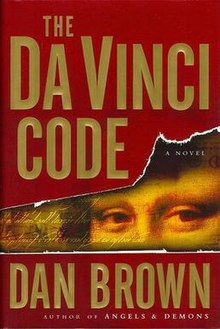Introduction:
"The Da Vinci Code," penned by author Dan Brown, is a gripping and controversial thriller that has left an indelible mark on the literary world. Released in 2003, this international bestseller seamlessly weaves together art, history, and religion into a fast-paced narrative, taking readers on a journey of cryptic codes, ancient secrets, and relentless pursuit.
Plot Overview:
The story follows Harvard symbologist Robert Langdon and cryptologist Sophie Neveu as they race across Europe to unravel a series of cryptic codes and symbols left behind by the murder victim, Jacques Saunière. The duo becomes entangled in a web of conspiracies that challenge traditional beliefs about the Holy Grail and the role of Mary Magdalene in Christianity. As they decipher hidden messages in famous works of art, they must evade a relentless adversary and uncover the truth before it is lost to the ages.
Themes and Controversies:
"The Da Vinci Code" delves into controversial theories about the nature of the Holy Grail, the divinity of Mary Magdalene, and the alleged cover-ups within the Catholic Church. Brown's masterful storytelling blurs the lines between fact and fiction, prompting readers to question historical narratives and consider alternative interpretations of well-known religious stories.
Art and History:
Central to the novel is the integration of art and history. Brown seamlessly incorporates famous works of art, such as Leonardo da Vinci's "The Last Supper," into the narrative, using them as clues to unravel the mysteries at hand. The novel's success lies in its ability to make the esoteric world of art and symbology accessible and thrilling for a wide audience.
Global Impact:
"The Da Vinci Code" became a literary phenomenon, captivating readers worldwide with its intellectual puzzles and adrenaline-pumping plot. Translated into numerous languages, the novel sparked discussions, debates, and even controversy, particularly among religious communities. Despite its fictional nature, the book ignited curiosity about the historical basis of its claims and prompted readers to explore the blurred boundaries between truth and fiction.
Adaptations and Legacy:
The success of "The Da Vinci Code" extended beyond the written word. In 2006, the novel was adapted into a film starring Tom Hanks as Robert Langdon. The book's popularity also fueled interest in similar works of historical fiction and conspiracy thrillers, solidifying its legacy in the genre.
Conclusion:
"The Da Vinci Code" remains a cultural touchstone, a literary work that transcended its genre to become a global phenomenon. Dan Brown's expert blending of mystery, history, and art invites readers to question established narratives and contemplate the secrets that may lie beneath the surface of our collective history. Whether one reads it for the thrill of the chase or the intellectual stimulation, "The Da Vinci Code" continues to be a captivating and influential work that invites readers to unlock the mysteries of the past.
Unveiling the Enigma: The Enduring Allure of "The Da Vinci Code" by Dan Brown
Cultural Impact:
"The Da Vinci Code" not only captivated the literary world but also left an indelible mark on popular culture. The novel's intricate puzzles, codes, and conspiracies spurred interest in secret societies, religious mysteries, and hidden messages within famous artworks. Tours and guides dedicated to locations featured in the book experienced a surge in popularity, transforming the novel into a cultural phenomenon that transcended the boundaries of fiction.
Character Dynamics:
At the heart of the narrative are the dynamic characters of Robert Langdon and Sophie Neveu. Langdon, a Harvard professor of symbology, serves as the intellectual anchor, while Sophie, a French cryptologist, brings a personal connection to the unfolding mystery. Their evolving relationship and shared quest for truth add a layer of depth to the novel, engaging readers emotionally alongside the intellectual unraveling of clues.
Controversy and Criticism:
"The Da Vinci Code" faced its fair share of criticism, particularly from religious institutions and scholars who contested its historical accuracy and theological interpretations. Some accused the novel of blurring the lines between fact and fiction, challenging established religious beliefs. Despite these controversies, or perhaps because of them, the book continued to thrive, sparking important conversations about the role of fiction in shaping public perceptions.
Writing Style:
Dan Brown's writing style in "The Da Vinci Code" is characterized by short chapters, rapid pacing, and cliffhangers, contributing to its page-turning quality. The incorporation of historical facts, symbols, and riddles creates an immersive reading experience, inviting readers to become active participants in solving the mysteries alongside the characters.
Sequels and Literary Influence:
Following the success of "The Da Vinci Code," Dan Brown continued to explore similar themes in his subsequent novels, featuring Robert Langdon in "Angels & Demons," "The Lost Symbol," "Inferno," and "Origin." While none achieved the same level of global impact as the first installment, they maintained Brown's reputation for combining thrilling narratives with intellectual intrigue.
Legacy and Continued Interest:
"The Da Vinci Code" remains a book that transcends generations. Its legacy is evident not only in its continued popularity but also in the myriad books, documentaries, and discussions it has inspired. The novel's themes of unraveling historical mysteries and questioning established truths continue to resonate with readers, ensuring its enduring place in the literary landscape.
In conclusion, "The Da Vinci Code" is more than a bestseller; it's a cultural phenomenon that challenged perceptions, ignited debates, and invited readers on a quest for hidden knowledge. Its enduring popularity speaks to the universal fascination with mysteries, art, and the age-old pursuit of understanding our complex past.


إرسال تعليق